 W
WIn animal anatomy, the mouth, also known as the oral cavity, buccal cavity, or in Latin cavum oris, is the opening through which many animals take in food and issue vocal sounds. It is also the cavity lying at the upper end of the alimentary canal, bounded on the outside by the lips and inside by the pharynx and containing in higher vertebrates the tongue and teeth. This cavity is also known as the buccal cavity, from the Latin bucca ("cheek").
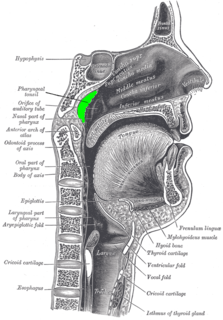 W
WAdenoid hypertrophy is the unusual growth (hypertrophy) of the adenoid first described in 1868 by the Danish physician Wilhelm Meyer (1824–1895) in Copenhagen. He described a long term adenoid hypertrophy that will cause an obstruction of the nasal airways. These will lead to a dentofacial growth anomaly that was defined as "adenoid facies".
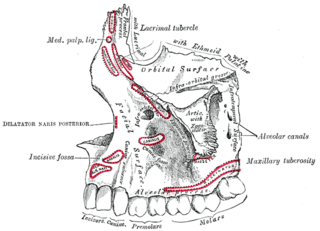 W
WThe alveolar process is the thickened ridge of bone that contains the tooth sockets on the jaw bones that hold teeth. In humans, the tooth-bearing bones are the maxilla and the mandible. The curved part of each alveolar process on the jaw is called the alveolar arch.
 W
WThe alveolar ridge is one of the two jaw ridges, extensions of the mandible or maxilla, either on the roof of the mouth between the upper teeth and the hard palate or on the bottom of the mouth behind the lower teeth. Most of the roof of one's mouth is the hard palate and the soft palate. The alveolar ridges contain the sockets of the teeth. They can be felt with the tongue in the area right above the top teeth or below the bottom teeth. Its surface is covered with little ridges.The [upper] alveolar ridge is a small protuberance just behind the upper front teeth that can easily be felt with the tongue.
 W
WAngularis nigra, Latin for 'black angle', also known as open gingival embrasures, and colloquially known as "black triangle", is the space or gap seen at the cervical embrasure, below the contact point of some teeth. The interdental papilla does not fully enclose the space, leading to an aperture between adjacent teeth. This gap has many causes including gingival recession, and gingival withdrawal post-orthodontic work. Interdental "black triangles" were rated as the third-most-disliked aesthetic problem below caries and crown margins. Treatment of angularis nigra often requires an interdisciplinary approach, involving periodontal, orthodontic and restorative treatment. Possible treatments to correct angularis nigra include addition of composite resin in the space, veneer placement, or gum graft. Angularis nigra is generally only treated based on the aesthetic preference of the patient.
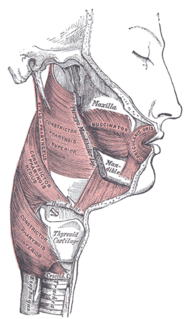 W
WThe buccal space is a fascial space of the head and neck. It is a potential space in the cheek, and is paired on each side. The buccal space is superficial to the buccinator muscle and deep to the platysma muscle and the skin. The buccal space is part of the subcutaneous space, which is continuous from head to toe.
 W
WThe canine space, is a fascial space of the head and neck. It is a thin potential space on the face, and is paired on either side. It is located between the levator anguli oris muscle inferiorly and the levator labii superioris muscle superiorly. The term is derived from the fact that the space is in the region of the canine fossa, and that infections originating from the maxillary canine tooth may spread to involve the space. Infra-orbital is derived from infra- meaning below and orbit which refers to the eye socket.
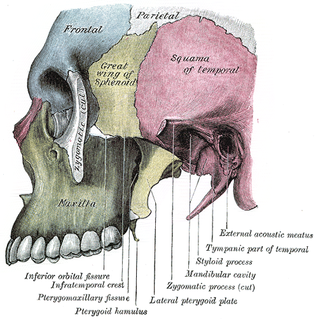 W
WThe deep temporal space is a fascial space of the head and neck. It is a potential space in the side of the head, and is paired on either side. It is located deep to the temporalis muscle
 W
WThe dental arches are the two arches of teeth, one on each jaw, that together constitute the dentition. In humans and many other species; the superior dental arch is a little larger than the inferior arch, so that in the normal condition the teeth in the maxilla slightly overlap those of the mandible both in front and at the sides. The way that the jaws, and thus the dental arches, approach each other when the mouth closes, which is called the occlusion, determines the occlusal relationship of opposing teeth, and it is subject to malocclusion if facial or dental development was imperfect.
 W
WThe embryological origin of the mouth and anus is an important characteristic, and forms the morphological basis for separating bilaterian animals into two natural groupings: the protostomes and deuterostomes.
 W
WIn human anatomy, the mouth is the first portion of the alimentary canal that receives food and produces saliva. The oral mucosa is the mucous membrane epithelium lining the inside of the mouth.
 W
WThe inferior alveolar nerve is a branch of the mandibular nerve, which is itself the third branch of the trigeminal nerve. The inferior alveolar nerves supply sensation to the lower teeth.
 W
WThe Infratemporal space is a fascial space of the head and neck. It is a potential space in the side of the head, and is paired on either side. It is located posterior to the maxilla, between the lateral pterygoid plate of the sphenoid bone medially and by the base of skull superiorly. The term is derived from infra- meaning below and temporal which refers to the temporalis muscle.
 W
WThe labrum is a flap-like structure that lies immediately in front of the mouth in almost all extant Euarthropoda. The most conspicuous exceptions are the Pycnogonida, which probably are chelicerate-relatives. In entomology, the labrum amounts to the "upper lip" of an insect mouth, the corresponding "lower lip" being the labium.
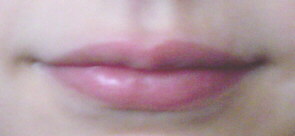 W
WLips are a visible body part at the mouth of many animals, including humans.
 W
WA lip frenulum piercing is a body piercing through the frenulum of either the upper or lower lip. A piercing through the upper lip frenulum is sometimes called a "smiley",,because it is usually only seen when smiling, or a "scrumper". Similarly, the lower lip frenulum piercing is sometimes referred to as a "frowny". Jewelry is recommended to be worn in the piercing for a short period of time because the risks associate with it are high.
 W
WThe mandible of an arthropod is a pair of mouthparts used either for biting or cutting and holding food. Mandibles are often simply referred to as jaws. Mandibles are present in the extant subphyla Myriapoda, Crustacea and Hexapoda. These groups make up the clade Mandibulata, which is currently believed to be the sister group to the rest of arthropods, the clade Arachnomorpha.
 W
WIn arthropods, the maxillae are paired structures present on the head as mouthparts in members of the clade Mandibulata, used for tasting and manipulating food. Embryologically, the maxillae are derived from the 4th and 5th segment of the head and the maxillary palps; segmented appendages extending from the base of the maxilla represent the former leg of those respective segments. In most cases, two pairs of maxillae are present and in different arthropod groups the two pairs of maxillae have been variously modified. In crustaceans, the first pair are called maxillulae.
 W
WThe mental space is a fascial space of the head and neck. It is a potential space, bilaterally located in the chin, between the mentalis muscle superiorly and the platysma muscle inferiorly. These spaces may be created by pathology, e.g., the spread of odontogenic infection. Commonly the origin of the infection is an anterior mandibular tooth with associated periapical abscess which erodes through the buccal cortical plate of the mandibular at a level below the attachment of the mentalis muscle.
 W
WA mouth assessment is performed as part of a patient's health assessment. The mouth is the beginning of the digestive system and a substantial part of the respiratory tract. Before an assessment of the mouth, patient is sometimes advised to remove any dentures. The assessment begins with a dental-health questionnaire, including questions about toothache, hoarseness, dysphagia(difficulty swallowing), altered taste or a frequent sore throat, current and previous tobacco use and alcohol consumption and any sores, lesions or bleeding of the gums.
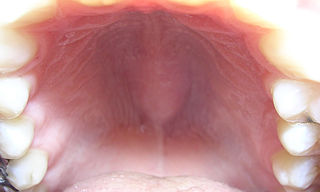 W
WThe palatine raphe is a raphe running across the palate, from the palatine uvula to the incisive papilla.
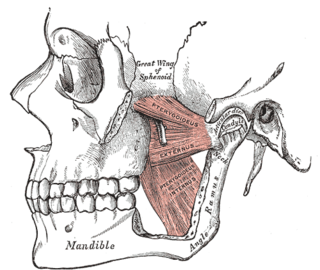 W
WThe pterygomandibular space is a fascial space of the head and neck. It is a potential space in the head and is paired on each side. It is located between the medial pterygoid muscle and the medial surface of the ramus of the mandible. The pterygomandibular space is one of the four compartments of the masticator space.
 W
WThe Salivary microbiome is the nonpathogenic, commensal bacteria present in the healthy human salivary glands. It is distinct from bacteria that may cause infection in the glands. It differs from the oral microbiome which is located in the oral cavity. Oral microorganisms tend to adhere to teeth. The oral microbiome possesses its own characteristic microorganisms found there. Resident microbes of the mouth adhere to the teeth and gums. "[T]here may be important interactions between the saliva microbiome and other microbiomes in the human body, in particular, that of the intestinal tract."
 W
WA smile is formed primarily by flexing the muscles at the sides of the mouth. Some smiles include a contraction of the muscles at the corner of the eyes, an action known as a Duchenne smile.
 W
WThe sublingual papilla or sublingual fold is a small fold of soft tissue located on each side of the frenulum linguae binding the lips to the gums within the mouth.
 W
WThe sublingual space is a fascial space of the head and neck. It is a potential space located below the mouth and above the mylohyoid muscle, and is part of the suprahyoid group of fascial spaces.
 W
WThe submandibular space is a fascial space of the head and neck. It is a potential space, and is paired on either side, located on the superficial surface of the mylohyoid muscle between the anterior and posterior bellies of the digastric muscle. The space corresponds to the anatomic region termed the submandibular triangle, part of the anterior triangle of the neck.
 W
WThe submasseterric space is a fascial space of the head and neck. It is a potential space in the face over the angle of the jaw, and is paired on each side. It is located between the lateral aspect of the mandible and the medial aspect of the masseter muscle and its investing fascia. The term is derived from sub- meaning "under" in Latin and masseteric which refers to the masseter muscle. The submasseteric space is one of the four compartments of the masticator space. Sometimes the submasseteric space is described as a series of spaces, created because the masseter muscle has multiple insertions that cover most of the lateral surface of the ramus of the mandible.
 W
WThe submental space is a fascial space of the head and neck. It is a potential space located between the mylohyoid muscle superiorly, the platysma muscle inferiorly, under the chin in the midline. The space coincides with the anatomic region termed the submental triangle, part of the anterior triangle of the neck.
 W
WThe tonsillar fossa is a space delineated by the triangular fold of the palatoglossal and palatopharyngeal arches within the lateral wall of the oral cavity..
 W
WA uvula piercing is a body piercing through the uvula, the projection of the soft palate between the tonsils. This is a rare piercing. Captive bead rings or other small rings are the most commonly seen jewellery in uvula piercings.
 W
WWhite roll is the white line that borders the top of the upper lip. It's an adnexal mass of specialized glands and fat. White roll occurs naturally for nearly everyone, although it can be not white and less visible for dark skinned individuals. Well defined white roll indicates youthfulness and is considered aesthetically pleasing.